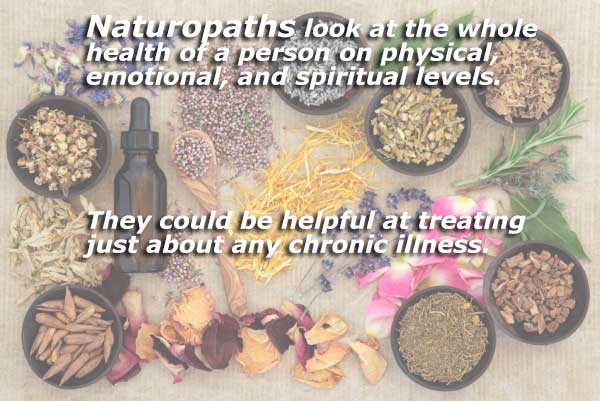 In addition, treatments are non-invasive and natural so they are not harmful, side effects are rare. Secondly, physicians focus on finding the root causes of the pain, unlike Modern Medicine that focuses on symptoms. Therefore, they eliminate the problems which allow a person’s body to heal, preventing the pain from getting worse with time. Thirdly, Naturopath’s help people live healthier lifestyles and give the advice to prevent future diseases.
In addition, treatments are non-invasive and natural so they are not harmful, side effects are rare. Secondly, physicians focus on finding the root causes of the pain, unlike Modern Medicine that focuses on symptoms. Therefore, they eliminate the problems which allow a person’s body to heal, preventing the pain from getting worse with time. Thirdly, Naturopath’s help people live healthier lifestyles and give the advice to prevent future diseases.
Naturopath physicians can help with chronic pain in general, chronic illnesses, diseases, mental health problems, or just general health issues. However, different naturopath practitioners specialize in different treatments, so it is a matter of finding the right physician for your needs.
Some Common Health Conditions Naturopaths help with include:
Autoimmune Disorders, Adrenal Fatigue, Allergies, Cancer, Chronic Pain in general, Chronic Fatigue, Digestive Issues, Fertility Problems, Fibromyalgia, Food Sensitivities, Heart Disease, Hormone Imbalances, Leaky Gut, Menopause, Obesity, Respiratory Conditions, Sleep problems, Thyroid Problems, Weight Loss, and more.
Here are some general success stories


 Naturopathic medicine (naturopathy) is based on the concept that the body has the natural ability to heal itself. A naturopath physician assesses a person as a whole, identifies the cause of the problem or illness, and treats it with natural solutions tailored to that patient. They also provide advice on lifestyle changes to treat health problems and even prevent them. Naturopathy is different from conventional medicine because conventional often treats or suppresses symptoms of chronic pain, illnesses, and diseases. Naturopathic physicians use both the wisdom of nature and modern science to diagnose, manage, treat, and prevent chronic health conditions.
Naturopathic medicine (naturopathy) is based on the concept that the body has the natural ability to heal itself. A naturopath physician assesses a person as a whole, identifies the cause of the problem or illness, and treats it with natural solutions tailored to that patient. They also provide advice on lifestyle changes to treat health problems and even prevent them. Naturopathy is different from conventional medicine because conventional often treats or suppresses symptoms of chronic pain, illnesses, and diseases. Naturopathic physicians use both the wisdom of nature and modern science to diagnose, manage, treat, and prevent chronic health conditions. The Healing Power of Nature: The body has the inherent ability to heal itself, restore, and maintain health. The physician’s job is to remove the problems and interferences to give the body a chance to heal. They also make it a point to educate the patient on lifestyle choices, and removing internal (mind/body) or external (environmental) interferences.
The Healing Power of Nature: The body has the inherent ability to heal itself, restore, and maintain health. The physician’s job is to remove the problems and interferences to give the body a chance to heal. They also make it a point to educate the patient on lifestyle choices, and removing internal (mind/body) or external (environmental) interferences. Nutrition: This may include dietary improvements, a nutrition plan, and the elimination of foods that cause allergies or are toxic for a person’s long-term health.
Nutrition: This may include dietary improvements, a nutrition plan, and the elimination of foods that cause allergies or are toxic for a person’s long-term health. In addition, treatments are non-invasive and natural so they are not harmful, side effects are rare. Secondly, physicians focus on finding the root causes of the pain, unlike Modern Medicine that focuses on symptoms. Therefore, they eliminate the problems which allow a person’s body to heal, preventing the pain from getting worse with time. Thirdly, Naturopath’s help people live healthier lifestyles and give the advice to prevent future diseases.
In addition, treatments are non-invasive and natural so they are not harmful, side effects are rare. Secondly, physicians focus on finding the root causes of the pain, unlike Modern Medicine that focuses on symptoms. Therefore, they eliminate the problems which allow a person’s body to heal, preventing the pain from getting worse with time. Thirdly, Naturopath’s help people live healthier lifestyles and give the advice to prevent future diseases. The concept of “the healing power of nature” can be traced back to Hippocrates, the Greek physician who lived 2,400 years ago. He is one of the most famous figures in the history of medicine and is still known as the “Father of Medicine.” The “healing power of nature” has been the central concept in medicine throughout the world for a very long time. It is also the central principle of naturopathic medicine.
The concept of “the healing power of nature” can be traced back to Hippocrates, the Greek physician who lived 2,400 years ago. He is one of the most famous figures in the history of medicine and is still known as the “Father of Medicine.” The “healing power of nature” has been the central concept in medicine throughout the world for a very long time. It is also the central principle of naturopathic medicine.
 In order to be a licensed Naturopathic physician (ND) in the United States a person must attend a four-year, graduate-level naturopathic medical school. There are seven accredited programs in the United States. They must be educated on all the same basic sciences as an MD. But, they also have to study holistic and nontoxic approaches to therapy with a strong focus on disease prevention and optimizing wellness. Coupled with their medical studies the Naturopathic physician also studies clinical nutrition, botanical medicine, homeopathic medicine, psychology, and counseling. But that’s not all, they need to pass meticulous professional board exams to be licensed by the state or jurisdiction as a primary care general practice physician. They are also required to complete clinical training (seeing patients under supervision). Naturopathic physicians receive more training than nurse practitioners and physician’s assistants.
In order to be a licensed Naturopathic physician (ND) in the United States a person must attend a four-year, graduate-level naturopathic medical school. There are seven accredited programs in the United States. They must be educated on all the same basic sciences as an MD. But, they also have to study holistic and nontoxic approaches to therapy with a strong focus on disease prevention and optimizing wellness. Coupled with their medical studies the Naturopathic physician also studies clinical nutrition, botanical medicine, homeopathic medicine, psychology, and counseling. But that’s not all, they need to pass meticulous professional board exams to be licensed by the state or jurisdiction as a primary care general practice physician. They are also required to complete clinical training (seeing patients under supervision). Naturopathic physicians receive more training than nurse practitioners and physician’s assistants.